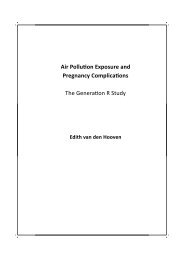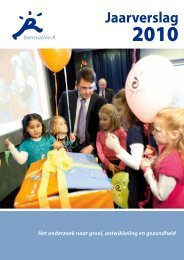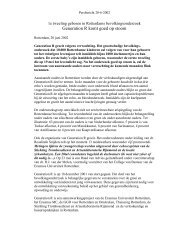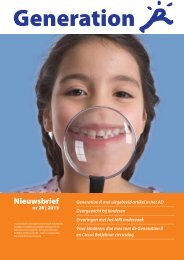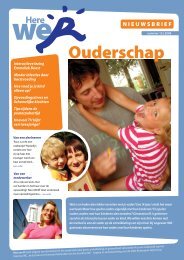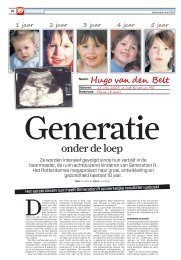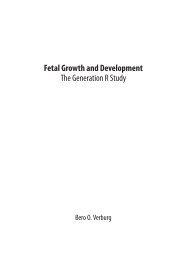Parents and infants: determinants of attachment in a ... - Generation R
Parents and infants: determinants of attachment in a ... - Generation R
Parents and infants: determinants of attachment in a ... - Generation R
Create successful ePaper yourself
Turn your PDF publications into a flip-book with our unique Google optimized e-Paper software.
Chapter 1<br />
can be classified as securely attached, <strong>in</strong>secure-avoidant, <strong>in</strong>secure-resistant<br />
(A<strong>in</strong>sworth et al., 1978) or disorganized (Ma<strong>in</strong> & Solomon, 1990). Securely<br />
attached children readily approach the caregiver to be comforted <strong>and</strong> then<br />
return to exploration <strong>and</strong> play. Insecure-avoidant children m<strong>in</strong>imize <strong>attachment</strong><br />
behavior <strong>and</strong> avoid contact with the caregiver. Insecure-resistant children<br />
maximize their <strong>attachment</strong> behavior, anxiously cl<strong>in</strong>g<strong>in</strong>g to the caregiver<br />
while at the same time angrily resist<strong>in</strong>g contact. The breakdown <strong>of</strong><br />
an organized <strong>attachment</strong> strategy that characterizes disorganized <strong>attachment</strong><br />
relationships is reflected <strong>in</strong> contradictory <strong>and</strong> <strong>in</strong>explicable behavior,<br />
such as stereotypical rock<strong>in</strong>g, lay<strong>in</strong>g down on the floor without mov<strong>in</strong>g or<br />
approach<strong>in</strong>g the caregiver while show<strong>in</strong>g signs <strong>of</strong> avoidance or fear.<br />
The importance <strong>of</strong> early <strong>attachment</strong> relationships for the socioemotional<br />
development <strong>of</strong> children is one <strong>of</strong> the central tenets <strong>of</strong> <strong>attachment</strong><br />
theory <strong>and</strong> has been demonstrated <strong>in</strong> numerous studies over the past thirty<br />
years. Young <strong><strong>in</strong>fants</strong> are not yet able to deal with stressful situations on their<br />
own <strong>and</strong> therefore rely on a caregiver to help them modulate their stress.<br />
It has been argued that children develop adaptive or maladaptive emotionregulation<br />
strategies with<strong>in</strong> their early <strong>attachment</strong> relationships <strong>and</strong> that<br />
these strategies affect the way they will respond to future stressful situations<br />
(Carlson, 1998; Sroufe, 1996; for a review see We<strong>in</strong>field, Sroufe, Egel<strong>and</strong>, &<br />
Carlson, 2008). Based on previous experiences, securely attached <strong><strong>in</strong>fants</strong> are<br />
confident that their caregiver will be available <strong>in</strong> stressful situations. This<br />
confidence provides these children with an effective mechanism to cope<br />
with stress: they can approach the <strong>attachment</strong> figure for help <strong>and</strong> comfort<br />
<strong>in</strong> stressful situations. Insecure <strong>and</strong> disorganized children on the other h<strong>and</strong><br />
lack such an effective cop<strong>in</strong>g strategy, which decreases the children’s ability<br />
to regulate their emotions <strong>and</strong> reactions to stress (Cassidy, 1994; Greenberg,<br />
Speltz, DeKlyen, & Jones, 2001; Guttman-Ste<strong>in</strong>metz & Crowell, 2006).<br />
Different <strong>attachment</strong> classifications reflect different strategies <strong>of</strong> deal<strong>in</strong>g<br />
with stressful situations: Insecure-avoidant children have a hypoactivat<strong>in</strong>g<br />
regulation strategy to avoid further rejection from an already unresponsive<br />
caregiver. Insecure-resistant children have a hyperactivat<strong>in</strong>g strategy, to<br />
assure the attention <strong>of</strong> an <strong>in</strong>consistently available caregiver. Disorganized<br />
children, whose regulation strategies are thought to collapse <strong>in</strong> stressful<br />
situations, are left without a reliable mechanism to regulate their emotions.<br />
It has repeatedly been shown that <strong>in</strong>dividual differences <strong>in</strong> <strong>attachment</strong><br />
quality have important implications for later adjustment (see DeKlyen &<br />
Greenberg, 2008 for a review). Whereas secure <strong>attachment</strong> is related to<br />
social competence <strong>and</strong> resilience (e.g. Belsky & Fearon, 2002; Edwards, Das<br />
Eiden, & Leonard, 2006; NICHD ECCRN, 2006), <strong>in</strong>secure <strong>and</strong> especially<br />
12



